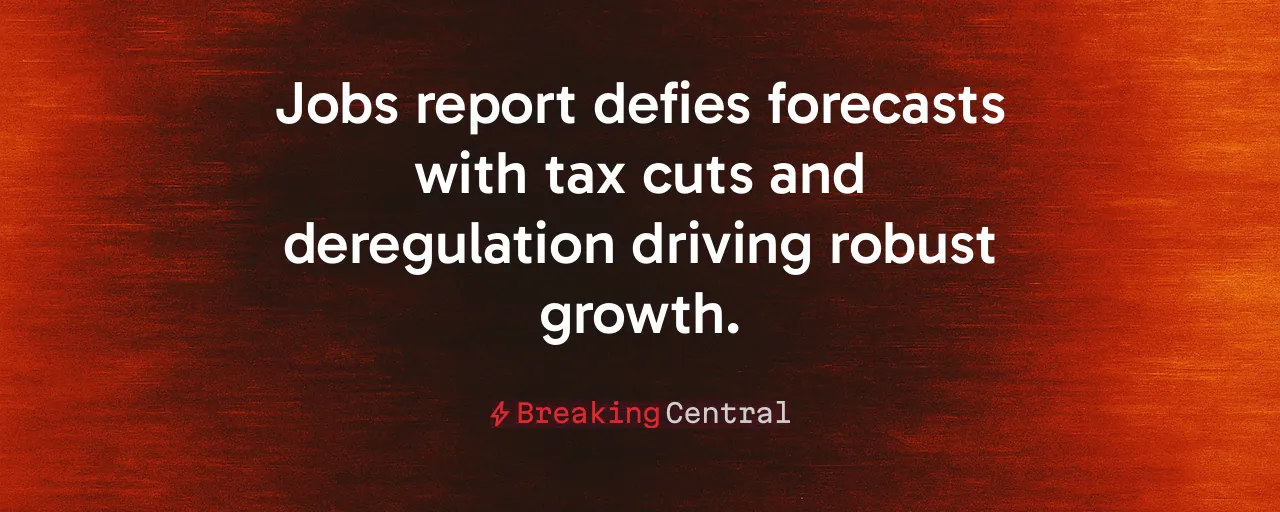A Jobs Report That Shakes the Skeptics
The latest jobs report surprised financial newsrooms. The Bureau of Labor Statistics revealed 147,000 new jobs in June 2025, far surpassing the 106,000 economists predicted. Unemployment dipped to 4.1 percent, defying expectations of a rise to 4.3 percent. Political commentator Benny Johnson quickly spotlighted Bloomberg's stunned reaction, framing it as proof that bold economic promises are being delivered.
This statistical win challenged the narrative of a slowing economy. For months, analysts pointed to rising tariffs, tighter immigration rules, and weaker private-sector signals as signs of trouble. The numbers tell a different story, one of resilience and momentum.
What's driving this surge? A closer look reveals a mix of policy wins and structural shifts. Tax cuts and deregulation have unleashed business confidence, while state and local governments have stepped up hiring. The report raises a critical question: can this growth hold, or will headwinds like tariffs or high interest rates derail it?
Policy Wins Behind the Numbers
The June jobs boom didn't happen by accident. Tax policies that prioritize business investment have fueled hiring, particularly in small and mid-sized firms. Deregulation has cut red tape, letting companies move faster to expand. Data from the Bureau of Labor Statistics shows upward revisions to prior months' job gains, signaling sustained strength.
State and local governments accounted for nearly half of June's job growth, hiring teachers, health-care workers, and administrators. This aligns with a push to empower states over federal bureaucracies, a strategy proving effective. Wage growth cooled to 3.7 percent annually, keeping inflation in check while still boosting workers' paychecks.
Tariffs, often criticized for disrupting trade, have bolstered certain manufacturing sectors by encouraging domestic production. While some factories face export challenges, the net effect has been job creation in industries like steel and electronics. These policies reflect a commitment to putting American workers first.
Challenging the Doomsayers
Financial media and some economists have been quick to predict economic trouble. They point to softer private-sector data, like ADP's report of job losses, or a slight dip in labor-force participation. These metrics warrant scrutiny alongside headline gains, though the labor market remains historically tight.
The labor market remains tight, with unemployment near historic lows and job gains outpacing population growth. Historical parallels are telling. In 2017 and 2019, similar tax and trade policy shifts caught forecasters off guard, leading to stronger-than-expected growth. Today's 4.1 percent unemployment rate, while above 2023's record low of 3.5 percent, is well below the 50-year average of 6.2 percent. This market is cooling yet remains robust.
Critics argue that tariffs could spark layoffs or that public-sector hiring masks private-sector weakness. The data shows broad-based gains, with health care, retail, and construction adding jobs. External pressures, such as high interest rates from a cautious Federal Reserve, pose the real risk.
Navigating Risks to Keep Growth Alive
Despite the good news, challenges loom. The Federal Reserve's reluctance to cut interest rates could slow investment and hiring. High rates, meant to tame inflation, risk choking off the momentum businesses need to grow. A single rate cut in 2025 could make a big difference, and policymakers could press for it.
Tariffs, while protective for some industries, create uncertainty for others. Manufacturers reliant on exports need clearer timelines to plan. Legal challenges to trade and immigration policies also pose risks, as courts could undo measures that have supported wage gains for low- and middle-income workers.
Falling labor-force participation, down by 100,000 in June, is another concern. Aging demographics and caregiving burdens are keeping some workers on the sidelines. Targeted training programs, especially in health care and advanced manufacturing, could bring them back while filling high-demand roles.
A Blueprint for Lasting Prosperity
The June jobs report offers a clear lesson: policies that trust businesses and states to lead deliver results. Staying the course on tax cuts and deregulation will keep the economy humming. Tariffs can remain a tool to protect American jobs, but with better communication to ease business uncertainty.
Empowering states to drive hiring, while trimming federal headcounts, balances efficiency with opportunity. Immigration policies that prioritize skilled workers and enforce limits can sustain wage growth without flooding the labor market. A modest rate cut from the Fed would signal confidence in the economy's path.
This moment calls for optimism tempered by vigilance. The jobs boom shows what's possible when policy aligns with the needs of workers and businesses. By addressing risks and doubling down on what works, the nation can build on this success for years to come.
